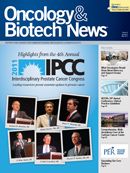Publication
Article
Leaving One "Haze" and Entering Another
Author(s):
The explosion of knowledge emanating from laboratories and clinics across the globe is steadily clearing the "haze" that shrouds the molecular basis of malignant cell transformation, growth, and spread

Andrew Pecora, MD
Editor-in-Chief Chief Innovations Officer, Professor, and Vice President of Cancer Services John Theurer Cancer Center at Hackensack University Medical Center
The explosion of knowledge emanating from laboratories and clinics across the globe is steadily clearing the “haze” that shrouds the molecular basis of malignant cell transformation, growth, and spread. It was first thought to be of limited clinical value to understand expressions of aberrant molecular pathways conferring a malignant phenotype. This began to change with the remarkable yet singular clinical success of identifying aberrant bcr-abl—induced tyrosine kinase activity as the cause of chronic myelogenous leukemia (CML). This led to development of a highly effective therapy, imatinib (Gleevec), that transformed the treatment of CML from an allogeneic transplant to a single pill taken daily
Now, with more recent approvals of other tyrosine kinase inhibitors (sunitinib), mTOR inhibitors (everolimus), histone deacetylase inhibitors (vorinostat), and hypomethylating agents (decitabine), the clinical value of clearing the haze is no longer in question.
As our patients benefit from the growing clarity of the molecular drivers of cancer, a new haze is blowing in with a ferocity driven by current economics. The federal deficit this year will exceed $1.5 trillion, adding to an already staggering national debt of approximately $14 trillion. Our aging population, compounded by medical breakthroughs that keep patients with disease alive longer, are poised to significantly add to our national financial burden.
The current proposed solution to limit the rate of growth of healthcare expenditures and improve quality of care is the so-called accountable care organization (ACO). At first blush, ACOs seem fairly straightforward: They allow healthcare providers to organize to deliver higher-quality care at a lower cost, and reward them for doing so. Similar to the early presumed understanding of the cause of cancer that turned out to be woefully superficial and inadequate, when one takes a careful look at the details of the presented inner workings of an ACO, it is not at all clear how it will affect the discovery and delivery of cancer care in the United States.
As currently planned, ACOs will consist solely of primary care doctors in partnership with other primary care doctors and/or hospitals. A primary care doctor can belong only to one ACO while specialists can belong to multiple ACOs. Is the delivery of cancer care a primary or specialty service? If ACOs are rewarded for cost savings, what will be the effect on delivery of effective but expensive cancer care in the context of overall cost of care in an ACO? How will clinical trials be integrated into the new system? What will become of cancer hospitals that do not employ primary care doctors?
These are but a few of the many questions facing cancer care delivery. Add to this the growing chorus of the need to eliminate wasteful care, which potentially includes life-extending cancer therapies that may not meet the current economic “value lens.”
For now it would appear that leaders in cancer care need to remain vigilant so that the investment of time, lives, and capital that resulted in clearing the “cancer haze” is not replaced with a new “economic haze” that again will cloud over the significant advances we have made in cancer discovery and care delivery.









